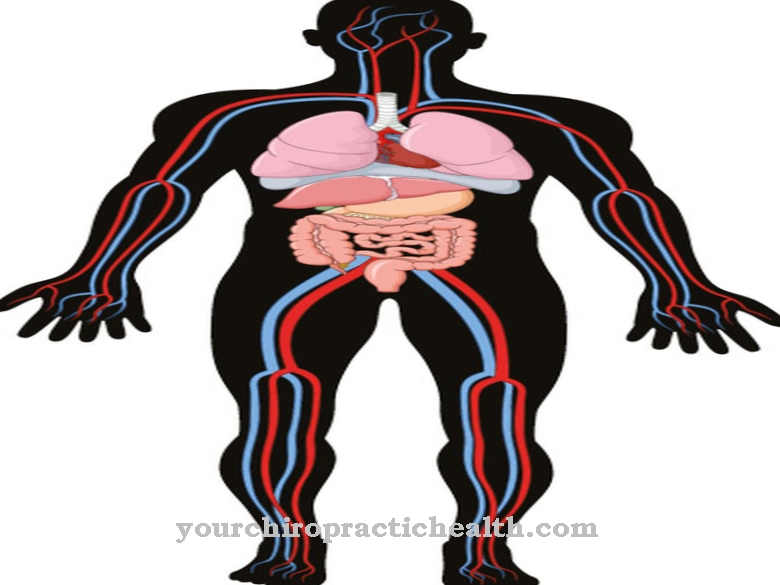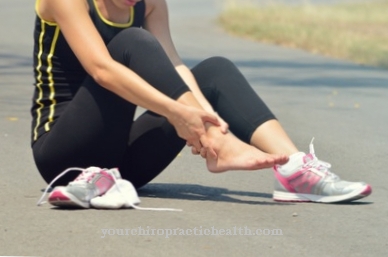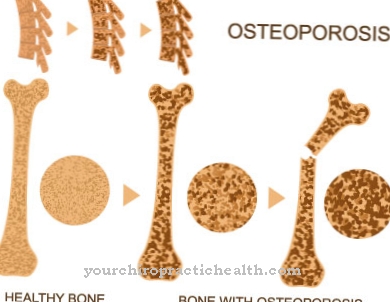A Phlebitis is a disease of the blood vessel system. From the name Thrombophlebitis with the ending -itis it can be seen that it is an inflammatory process that can affect different age groups.
What is phlebitis?
Under one Phlebitis or Thrombophlebitis an inflammation of the blood vessels, primarily the veins. The pathological processes associated with phlebitis do not affect the deep-lying veins, but rather the superficial areas.
In addition, phlebitis is characterized by the fact that the areas of inflammation do not affect the entire vein, but occur locally. Veins are blood vessels that transport the blood to the heart and can be partially or completely closed by a clot due to the formation of clusters of different proteins in the blood, in particular the platelets. These clumps, which are technically precisely referred to as thrombus, can lead to inflammatory changes in the surface veins.
causes
The causes one Phlebitis have been researched for a long time and can be caused by both internal and external influences. Phlebitis most often occurs when people have impaired motor skills. This can be the case as a result of a stroke, damage to the extremities, or long-term bed rest.
In addition, damage to the structures of the inner walls of the veins leads to phlebitis. Some people have an abnormally high tendency to clot prematurely. This can be caused by disorders of the coagulation system and pose a risk for the premature formation of clots.
After surgery, childbirth, a weak vein wall or accidents and as a result of diseases that are characterized by inflammation and existing tumors, phlebitis can be the cause.
Course of disease
At a Phlebitis different forms of the course are noticeable. Phlebitis is a disease that predominantly affects women and manifests itself in the form of varicose veins or as typical signs of inflammation in a previously healthy vein.
These signs are initially more characteristic to the extent that those affected only suffer from mild symptoms at the beginning. In addition to painful symptoms in the area of the affected vein, phlebitis, depending on the stage, more or less severe redness, swelling and heat build-up in the respective region.
If a blood clot forms that is so large that the vein is blocked, a so-called deep vein thrombosis occurs. The corresponding area becomes hard, the skin tenses and is very sensitive to pain when you touch it manually. Since the thrombus can loosen and lead to a life-threatening pulmonary embolism, it is necessary to see a doctor immediately.
Symptoms, ailments & signs
Doctors differentiate between two types of phlebitis. The location of the inflammation can be either on the surface or deep. Depending on the configuration, there are different symptoms. In technical jargon, the inflammation on the surface is referred to as thrombophlebitis, and on the deep veins as phlebothrombosis. Pain occurs even with small muscle loads.
Statistically speaking, the legs are predominantly affected by phlebitis. The superficial phlebitis manifests itself in a reddening of the skin. Often the affected area is warm. You may also experience an itchy rash. If you touch the surface lightly, you will experience pain. If there is a bacterial infection for the phlebitis, patients usually also suffer from a fever.
The deep phlebitis usually appears in the leg and pelvis. There pain and feelings of tension arise. It is characterized by a bluish coloration of the skin. The vessels stand out conspicuously. Swelling can be seen in contrast to superficial inflammation.
The symptoms of phlebitis usually subside after a few days. Those who have no previous illnesses will then have recovered. Serious cases last longer and are often related to varicose veins. Vein thrombosis also causes pain for weeks.
Complications
If the phlebitis is common, complications are rare. This form of thrombophlebitis usually heals without any consequences. However, if there is a pronounced varicose vein, surgical therapy is usually required. One of the greatest risks of phlebitis in superficial veins is that the inflammation spreads to the deeper venous system.
If this is affected, there is an increased risk of a blood clot, which medical professionals refer to as thrombosis. In extreme cases, the blood clot penetrates the bloodstream to the lungs, which can then result in a blockage of vessels or a pulmonary embolism. In the worst case, this ends with the death of the patient.
In addition to pulmonary embolism, a heart attack or stroke are also possible. To avoid complications such as pulmonary embolism, it is important to identify and treat inflammation in the veins in a timely manner. In around 30 percent of all patients who suffer from superficial phlebitis, the deep venous system is impaired.
Infection of the veins is also one of the dangerous effects of phlebitis. In most cases this is an infection with bacteria. It often shows up at the puncture sites of permanent cannulas. It makes itself noticeable in chills and fever. Most patients then require hospital treatment.
When should you go to the doctor?
With phlebitis, the patient should always consult a doctor. Although phlebitis can heal itself in some cases, the disease should always be treated by a doctor to prevent further complications. As soon as the first signs or symptoms of the disease appear, the person affected should therefore contact a doctor. Early detection and treatment of this disease always has a positive effect on the further course of the symptoms.
A doctor should be contacted in the case of phlebitis if the person affected suffers from a rash on the skin. This is usually associated with itching and also hurts. In severe cases, it can also lead to a fever or other symptoms of a cold. A blue discoloration of the skin can also indicate the phlebitis and should be examined by a doctor if it persists over a long period of time. The disease can usually be treated well by a general practitioner, so that the person affected does not have a reduced life expectancy.
Treatment & Therapy
In the therapy of Phlebitis are used in addition to special drugs that inhibit the inflammatory processes in the vein, relieve pain, and external procedures are also used as internal applications. In this regard, a zinc glue bandage or bandages with heparin ointment can be used to reduce the inflammation in the case of phlebitis.
In addition, it is therapeutically important to wear compression stockings to improve and support the return of blood from the veins. A blood clot can be removed with minimally invasive surgical procedures. The focus of therapeutic care, which also includes the follow-up treatment of a vein inflammation that has been overcome, is the avoidance of a pulmonary embolism.
In this context, depending on the stage of the phlebitis, it can also be important to keep bed rest for a short time. This is particularly the case with newly developed thromboses in the thighs.
prevention
To one Phlebitis To prevent this, it makes sense to avoid being overweight and to do as much physical activity as possible. The consumption of nicotine and alcohol should be restricted or avoided and with some medications, such as the birth control pill, regular check-ups should be carried out.
A sufficient supply of fluids and prevention with heparin after surgery are also good prophylaxis against phlebitis. Basically, patients who live with a high risk of developing another thrombosis are also treated preventively with the anticoagulant heparin. In addition to drinking plenty of fluids, it is also important to move and walk in the summer months.
Aftercare
In most cases, phlebitis does not require any direct or special follow-up measures. The disease can usually be treated again relatively easily, so that there are no further complications or complaints. However, the earlier the phlebitis is detected, the better the further course of the disease will usually be.Those affected should therefore ideally consult a doctor at the first symptoms and signs.
Many of those affected are dependent on taking various medications. It is always important to ensure that it is taken regularly and that the dosage is correct in order to counteract the symptoms correctly and permanently. In addition, those affected should wear compression stockings in order to completely heal the phlebitis.
If you have any questions, or if you have any side effects, a doctor should be consulted first. The person affected should generally rest and take it easy with this disease, whereby strict bed rest must be observed in serious cases. The support and help of your own family can also be very helpful and alleviate the symptoms. The phlebitis usually does not reduce the life expectancy of the person affected.
You can do that yourself
There are some home remedies that can help with phlebitis. Home remedies that can be used to cool down and reduce inflammation are, for example, quark compresses. Cold quark should be applied as thick as a finger on a swaddle or pure quark should be applied to the affected areas. Such wraps have a decongestant and anti-inflammatory effect.
But not only quark, medical alcohol and apple cider vinegar can also be used for pleasant cooling in case of phlebitis. But first they should be diluted with water. Cloths are then soaked in the diluted liquid and wrapped around the affected areas. The effect is very relaxing and noticeably alleviates the symptoms of phlebitis. Clay can also be used as a soothing clay pack. The clay has a particularly anti-inflammatory and decongestant effect. It should be mixed with water until it becomes a paste and then applied to the affected area as thick as a finger.
Since many smaller blood clots are formed in the case of phlebitis, you should prevent them from getting bigger. This can be achieved by accelerating the blood circulation. The use of compression bandages or support stockings can help. If possible, more exercise should be brought into everyday life. Easy walking, swimming, cycling, and walking are best for phlebitis.












.jpg)



.jpg)










.jpg)
